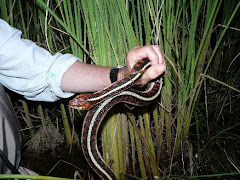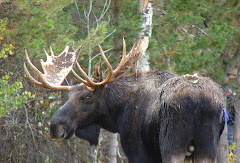
This is a male coho salmon. Note the bright red coloration and the large, hooked jaw. These characteristics are only present on the male.
This is a male chinook (or "king") salmon. This is what you usually get when you order salmon in a restaurant. This is also a spawning male, with a hooked jaw and the red coloration.
The differences are in size (chinook can get up into the hundreds of pounds) and coloration. Coho are also called "silver salmon" because of their silvery undertones. The chinook is darker, almost green, beneath his bright spawning colors. He's also got comma-shaped dorsal speckles on his back and fin. There are other differences, but we can stop there.
All I know is what I see.... or don't see. And this past winter (2007-2008), I didn't see any coho in my streams. None. That hadn't happened to me ever, not in the past ten years.
Coho have a rather rigid, three-year life cycle (under normal conditions without hatchery influence, then things change a bit). This means that when a coho comes back to its natal stream to spawn, it is invariably three years old, and it will be breeding only with other coho that are also three years old. They form what are known as "year classes", which means that what happened to coho in 2005 is going to directly impact what happens to coho three years later, in 2008. In central California, the 2002-2005-2008 year class was the strongest year class. It had good solid numbers and was in the best shape of the three. We were expecting to see coho all over the place last winter, the way we had in 2005, 2002 and every three years prior. We were stunned when none showed up at all. What the hell happened?
Most scientists agree that the crash was inevitable. A very lively discussion takes place on this blog: http://blog.epa.gov/blog/2008/07/11/realityaboutsalmon/
Everything from habitat loss to global climate change to human overpopulation is tagged as a culprit. And these are some of the top minds in fisheries management debating this (with a few token reactionaries thrown in to alleviate the tedium of fact exchange). Sadly, I doubt you will find our Republican VP nominee taking part in these discussions since they involve neither lipstick, nor guns, nor fuck-me pumps.
In my neck of the woods, it was all about poor ocean conditions. All of the little salmon, newly spawned in 2004 and hatched out in 2005, swam happily downstream in the spring expecting to gorge themselves on all of that delicious krill that exists because of the cold, nutrient-rich, upwellings that occur off the California coast and that drive the entire ecosystem immediately offshore. Only thing was, in 2005... the upwelling never came. The result: starvation and reproductive failure in almost every near-shore dependent species of fish, bird and mammal. And that includes juvenile salmon parr. Steelhead use the ocean much differently than coho do (steelhead are immediately far-ranging, coho stick close to shore until their 2nd year of life), so they were relatively unaffected by this phenomenon and their numbers have remained relatively strong.
But for how long?
Predictions are that the pendulum of the Pacific Decadal Oscillationhas swung back around again and that conditions should drastically improve off our shores for the coming year.
Time will tell. When the coho come back, I'll be here waiting for them.




1 comment:
You are amazing...
Post a Comment